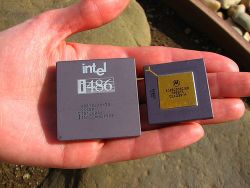Integrated circuit
An integrated circuit, or IC, is a semiconductor-based electronic device, sometimes as small as a human fingernail, that contains many switching elements, or transistors. Integrated circuits are often referred to simply as chips.
The first integrated circuits were invented separately around 1958 by Jack Kilby at Texas Instruments, and by Robert Noyce at Fairchild Semiconductor. The invention of the IC paved the way for the seminal introduction, in the early 1970's, of the first "single-chip" microprocessors such as the Intel 8080 processor first sold in 1974. These circuits were tiny piles of rotating layers of semi-conductors and insulators which were capable of constructing, in the block of a circuit, a certain number of transistors. These transistors, which were interconnected into macroscopic circuits in the same block, allowed for the creation of memories, as well as arithmetic and logic units. This revolutionary concept concentrated on a maximum number of logic functions in an unbelievably reduced space. These functions reached the exterior of the unit through connections which were spread out over the periphery of the circuit[1].
References
- ↑ Waldner, Jean-Baptiste (2007). Nanocomputers and Swarm Intelligence. John Wiley-ISTE, p38. ISBN 1847040020.
